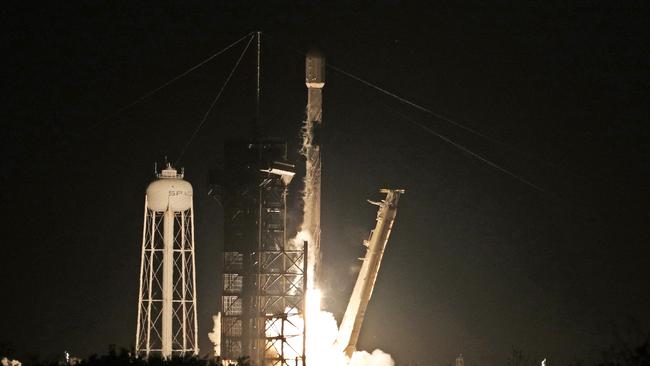Private US moon mission blasts off
A US company is aiming for its second lunar touchdown after a lander carrying a suite of unique experiments was launched aboard a SpaceX rocket on Wednesday, local time.

A US company is aiming for its second lunar touchdown after a lander carrying a suite of unique experiments was launched aboard a SpaceX rocket on Wednesday.
Intuitive Machines made history last year as the first private entity to put a robot on the moon, though the triumph was marred by the lander tipping onto its side – something it hopes to avoid this time around.
The Houston-based firm’s hexagonal-shaped lander, Athena, blasted off in a SpaceX Falcon 9 rocket from NASA’s Kennedy Space Centre in Florida.
If all goes well, it will touch down around March 6 at the vast Mons Mouton plateau, a site closer to the lunar south pole than any previously targeted.
Athena carries scientific instruments, including a drill to search for ice beneath the surface and a first-of-its-kind hopping drone named Grace after a famous computer scientist, Grace Hopper.
It is designed to traverse the moon’s rugged inclines, boulders, and craters – a valuable capability to support future crewed missions.
Also aboard is a small rover, which will test a lunar cellular network provided by Nokia Bell Labs by relaying commands, images, and video between the lander, rover, and hopper. This network is planned to eventually be integrated into astronauts’ suits.
Intuitive Machines CEO Trent Martin spoke excitedly about the hopper, emphasising that such drones could complement rovers in future missions by going “down into extreme environments where you can’t drive”, including lunar pits and underground passages carved by ancient lava flows.
Until recently, soft lunar landings were achieved only by a handful of well-funded national space agencies. Now the US is working to make private missions routine through the Commercial Lunar Payload Services program, a public-private collaboration aimed at delivering NASA hardware to the surface at a fraction of the cost of traditional missions.
“I’m very excited to see the science that our tech demonstrations deliver as we prepare for humanity’s return to the moon and the journey to Mars,” NASA’s Nicky Fox told reporters, referencing the Artemis program, which aims to return astronauts to the lunar surface later this decade.
First, however, Intuitive Machines will want to achieve an upright landing – a feat the company fell short of with its previous lander, Odysseus, which went into space in February 2024.
It came down too fast, caught a foot on the surface and tipped over, coming to rest at a 30-degree angle. This limited its ability to generate solar power and prevented it from completing NASA experiments.
Landing on the moon is challenging due to the absence of an atmosphere, which rules out the use of parachutes.
Instead, spacecraft must rely on precisely controlled thruster burns to slow their descent.
Athena’s arrival at the moon is set to be preceded on March 2 by another private US lander, Firefly Aerospace’s Blue Ghost, which launched on a more circuitous journey back in January, sharing a ride with Tokyo-based ispace’s Resilience lander.
Also hitching a ride on this rocket will be NASA’s Lunar Trailblazer probe, which will enter orbit after a four-month journey and begin a two-year mission to study the distribution of different forms of water on the moon.
AFP



To join the conversation, please log in. Don't have an account? Register
Join the conversation, you are commenting as Logout